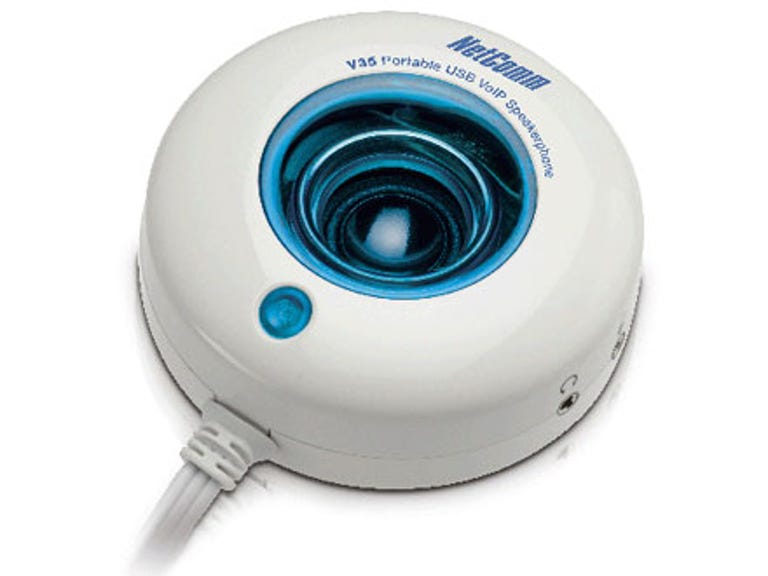 Why You Can Trust CNET
Why You Can Trust CNET NetComm V35 portable USB VoIP speakerphone review: NetComm V35 portable USB VoIP speakerphone
The V35 works admirably as a speakerphone for any VoIP application on any modern computer platform, although you may have a touch of sticker shock at the asking price.
Design
Netcomm's V35 Portable USB VoIP Speakerphone has a distinct
design philosophy, and it's one that's (at least arguably) been
borrowed from the Apple Mac world. To be specific, the V35 looks
like it'd be the perfect partner to the very original "Bondi Blue" iMac. It's a small speaker dressed
in mostly white plastic with a deep blue centre where the main
speaker body sits, and a single green light to indicate that it's
getting power via USB.
The Good
The Bad
The Bottom Line
Features
The V35 ranks among the easiest bits of technology to install
we've ever seen. Simply plug the V35's USB plug into any USB port
-- it matters not if it's USB 1.1 or 2.0, as it's just using USB
for power. This also makes the V35 entirely driverless, and
technically compatible across the entire Windows, Linux and OS X
worlds -- we tested with Windows, but can't see any reason it
wouldn't work elsewhere. Then just plug in the microphone and
headphone sockets into the relevant ports on your soundcard of
choice, and you're away.
The V35 will then instantly power up, with volume control being the only onboard control you've got, although it'll also support plugging in additional headphones or compatible mobile phones from a pair of standard audio sockets on the side. The one catch with using the V35 for VoIP calls is that as a natural consequence of plugging it into your headphone socket, it takes over all the audio duties of your system, from VoIP calls to music playback and even system beeps.
The other catch with the V35 is that it's a purely PC-centric VoIP solution. If you've invested in some VoIP hardware -- and Netcomm's own V100, V300 and NB9W spring instantly to mind -- then there's no point in picking up the V35, as it's not cross compatible with most phone handsets -- and you'd still need a USB socket around to power it.
Performance
We tested the V35 using Engin's eyeBeam softphone application,
although the V35's compatible with any VoIP softphone, or indeed
any application that requires a speaker and microphone in one. On
the caller end we found audio quality to be acceptable. Likewise,
on the reciever end we found the microphone had quite good pickup
from a reasonable but not extensive distance away from the
speaker. Our one concern on both ends was that audio volume was
quite soft on some calls, even with the unit's inbuilt speaker
turned up full and our Windows audio settings cranked up. It's
impossible to accurately tell whether this is a fault of the unit
or the calling software, however, so we expanded our test
environment beyond VoIP applications.
Testing pure audio output with music files revealed the V35 to have a higher volume level than we'd otherwise have expected, although it's still on the lower and softer side. We also tested the unit using Atari's Dungeons & Dragons Online: Stormreach game, which gave us a good testing ground for how well the embedded microphone picks up speech for multiple recipients. For the most part our gaming companions could hear us well with only a few quirks. Again there's the possibility that network conditions and the application itself could introduce issues with audio pickup.
Overall, we found the V35 worked well enough as a speakerphone, although we still suspect that you could struggle with it for multi-user VoIP applications in a noisy room. There's definitely a market for a VoIP speakerphone product, whether you're interested for family chats with multiple talkers on one end, or just feel silly or uncomfortable wearing a VoIP headset for an extended period of time. The asking price will undoubtedly deter some, and at AU$129, we'd argue that you'd need to be keen on VoIP through a speakerphone to justify the asking price -- that's not to say that it's automatically overpriced, but just that it's a hefty investment to make for a speakerphone alone.


